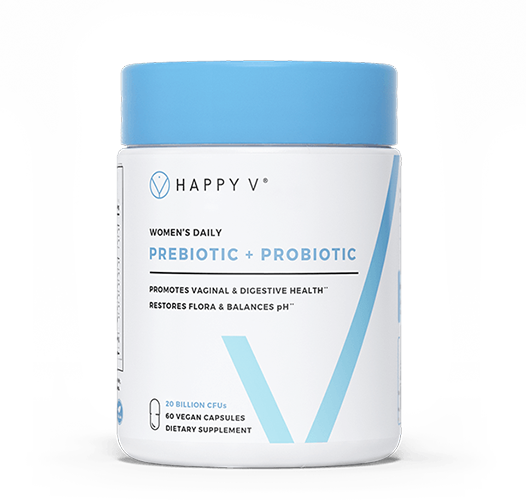Probiotics. Sure, you know what they are, but do you know what they REALLY are? That’s what we’re here to discuss. Because between all the social media buzz and the stone-cold science, it’s pretty obvious probiotics are here to stay.
Daily probiotics have been heralded as one of the best things you can take for your gut, your brain, and your overall vaginal health. And they have been called game-changers for people struggling with active bacterial vaginosis infections or recurrent bacterial vaginosis. But is all this really true?
The short answer is yes, but only if you take a quality probiotic. And it can be harder than you think to find one, given that everyone and their mother is producing them these days. We’ll share what a probiotic is, how it works, and how you can cut through the marketing jargon and find a quality supplement.
What Is a Probiotic?
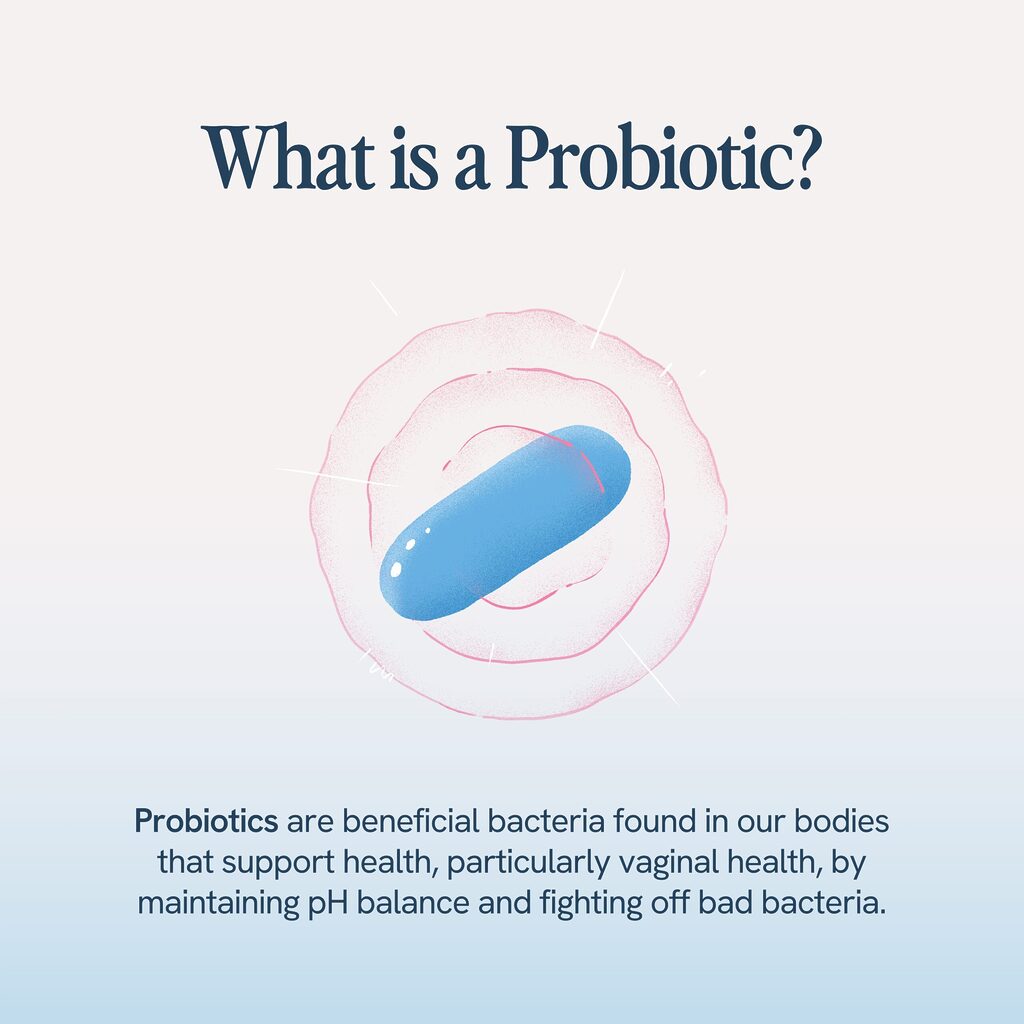
Before we get in the weeds about probiotic species and strains, let’s back up and talk about what probiotics actually are. Probiotics are beneficial bacteria that live and populate inside your body. These single-celled, microscopic organisms can be found in every organ in the human body. They support gastrointestinal and immune health and generally keep things functioning as they should. In terms of your vagina, probiotics, and specifically a probiotic called lactobacillus, are responsible for maintaining your overall vaginal pH and fighting off bad, infection-causing bacteria, like Gardnerella vaginalis, which causes bacterial vaginosis.
It’s normal for bad bacteria, like Garderella vaginalis, to enter your body. But if your body has enough probiotics, they can prevent the G. vaginalis from growing and causing bacterial vaginosis. So, by taking daily probiotics, you are not eliminating all bad bacteria but instead promoting the bacterial balance your body needs to stop the bad bacteria from causing problems.
How do I choose the right probiotic supplement?
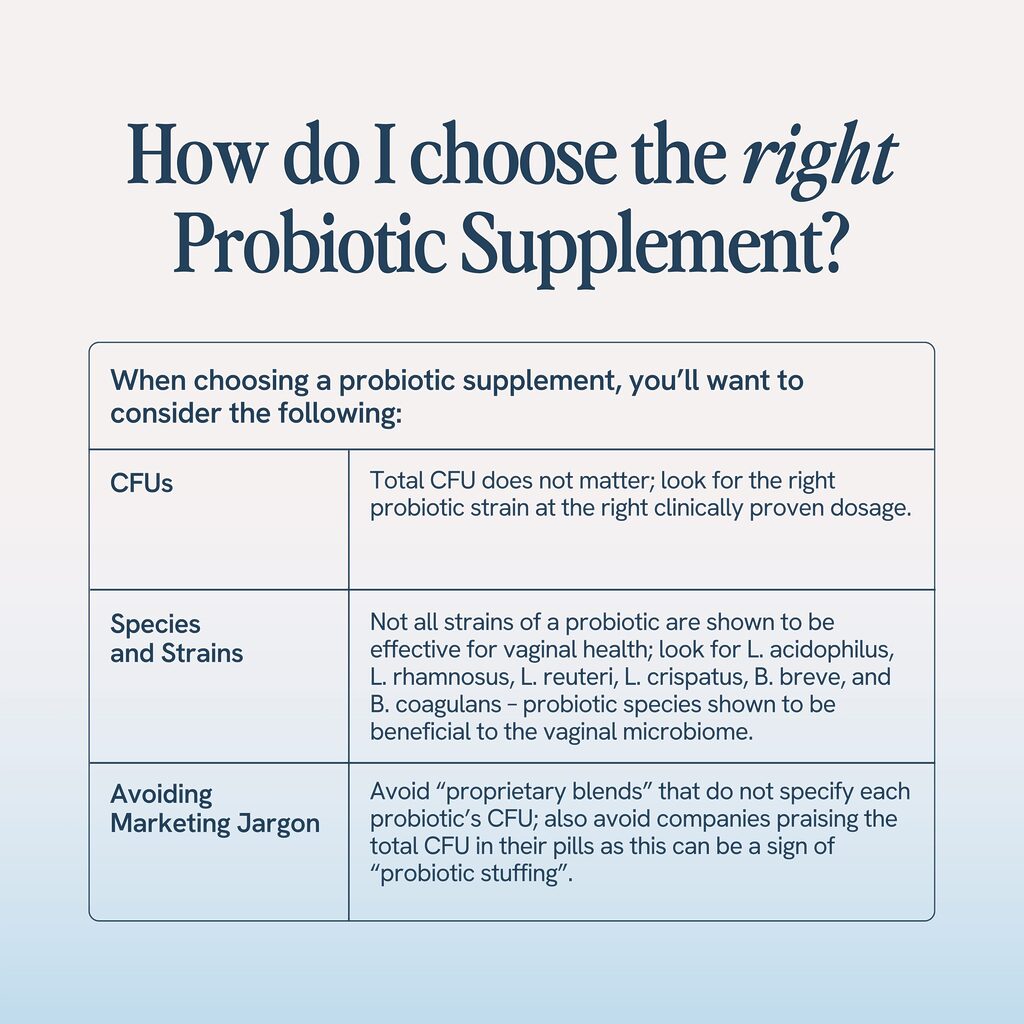
This is the big question, isn’t it? With so many probiotic supplement options out there, you can’t rely on a brand name or what the brand itself tells you. You need to look at the label on the bottle and see for yourself.
But the labels on probiotic supplements aren’t like traditional food labels. Probiotics often don’t contain calories or nutrients, and they don’t measure using ounces or grams. They use a measurement standard called colony-forming units, or CFUs. But the real kicker when it comes to probiotics is the names of the ingredients themselves. Because with names like “lactobacillus” they all sound scientific enough, but they might not actually be effective.
Let’s dive into the probiotics’ names first. And stick with us because it’s a bit of a doozy, but understanding this information will allow you to take your health into your own hands and not fall prey to marketing schemes.
Deciphering a Probiotic Culture’s Name
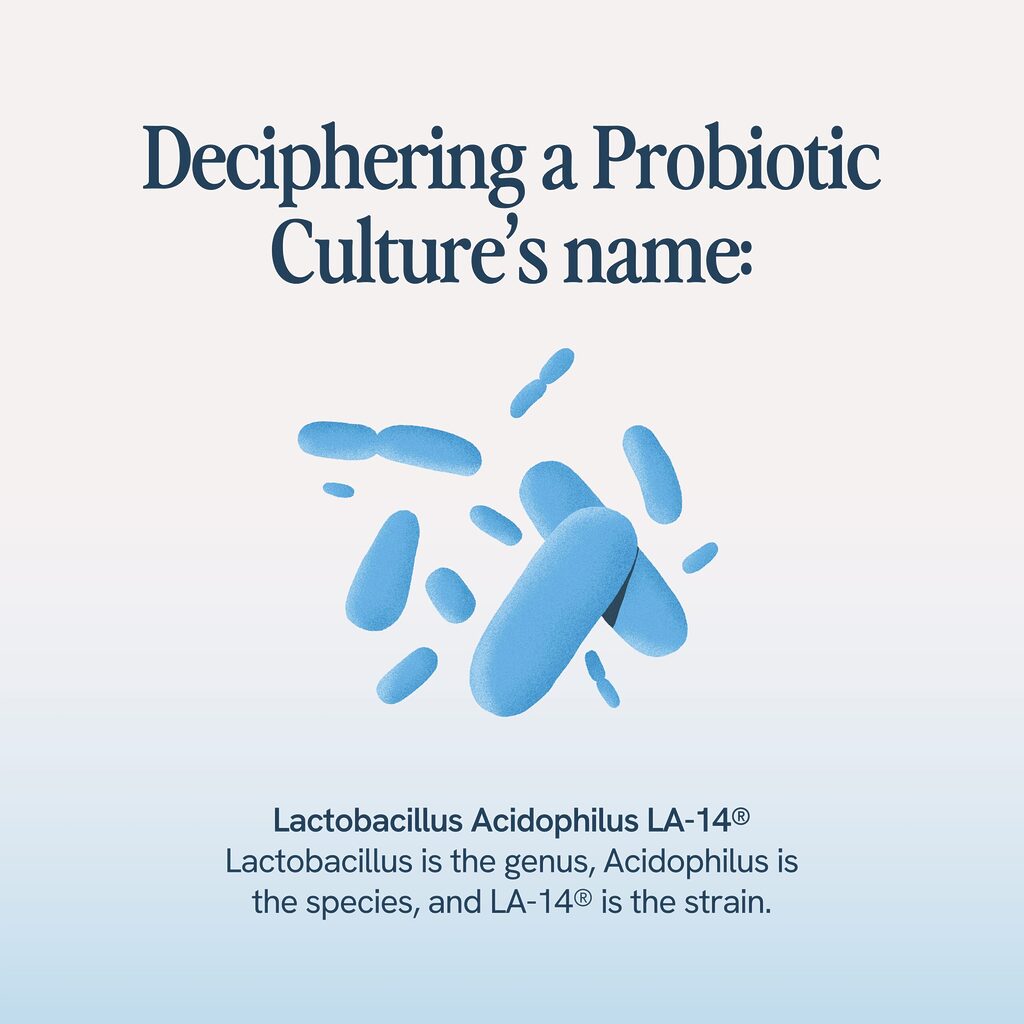
One of the most beneficial probiotics for vaginal health is the probiotic Lactobacillus. It produces the lactic acid and hydrogen peroxide that maintains your vaginal pH and fights bad bacteria. When you look at a vaginal probiotic supplement, you’ll notice multiple lactobacillus species within the same formula. That’s because every probiotic culture can be broken down into three elements: the genus, species, and strain. And deciphering this matters since not all strains of lactobacillus are shown to be effective.
Let’s break down one of the contents of Happy V’s Prebiotic + Probiotic: Lactobacillus Acidophilus LA-14®.
Our Happy V® Prebiotic + Probiotic was created for anyone who is experiencing symptoms related to Bacterial Vaginosis and Yeast Infections. Eliminate the odor, itch, gut bloating, and other symptoms.
Lactobacillus is the genus, acidophilus is the species, and LA-14® is the strain.
1. The probiotic genus
Every living organism — animals, plants, and single-celled probiotics — is broken down into a genus and then a species. The genus describes a general family or group of organisms that share some basic similarities but may actually be quite different. Take the genus “Canis” for example. It’s the Latin classification for dogs, but “Canis familiaris,” or a domesticated dog, looks and acts a whole lot different than “Canis lupus,” or a grey wolf.
The same goes for Lactobacillus. Lactobacillus is a probiotic genus, but under that genus, there are many, many different species and strains, and not all behave the same way within your vaginal microflora. So it’s not enough to check that a vaginal probiotic contains Lactobacillus. You need to know and understand the exact kind of Lactobacillus included in the formula to determine if it’s a quality probiotic.
2. The probiotic species
As you might have inferred from our above explanation of dogs, species are genetically different subsets of the same genus. And when it comes to probiotics specifically, different probiotic species have different therapeutic benefits for different parts of the body.
The most common probiotics species you’ll see mentioned with vaginal probiotics specifically are L. acidophilus, L. rhamnosus, L. reuteri, L. crispatus, B. breve, and B. coagulans—all of which are found in Happy V’s Prebiotic + Probiotic. (If you’re wondering what the heck that “B” means, it stands for Bifidobacteria, another super beneficial bacteria to the vaginal microbiome.)
Of all these species, the most important as it relates to vaginal wellness is Lactobacillus acidophilus, which makes up 95% of the vaginal flora.
But believe it or not, we actually have to dig even deeper than the species and look into the specific strain.
3. The probiotic strain
To understand why probiotic strains are important, we need to go back to our dog example. So, we know how a domesticated dog differs greatly from a wild wolf. But within that domestic dog species, there are still more subsets that are all quite different from each other. There are chihuahuas, labradors, and great danes. All share the same genus, but all definitely look and behave differently.
So, let’s go back to our original example with the Happy V probiotic: Lactobacillus acidophilus LA-14®.
LA-14® is the strain of acidophilus, and it’s one that has been clinically proven to colonize the vagina in 40 women in a double-blind, placebo-controlled clinical study at a dosage of 8 billion CFU per day. That’s significant because not every strain of L. acidophilus behaves and populates this way within the vaginal microflora. In fact, only the lactobacillus strain LA-14 ® was shown to have this effect.
So, hopefully, you can see why understanding specific probiotic strains matters. By understanding which strains are effective, you know what to look for in a supplement and don’t end up paying for a probiotic strain with no clinical evidence.
What are the most effective probiotic strains for women’s health and vaginal wellness?
So you already know that Lactobacillus acidophilus is the biggie when it comes to vaginal wellness since it helps maintain the vagina’s acidic environment, but other probiotic strains have been shown to benefit women, too. These include:
- Lactobacillus rhamnosus, which supports digestive and immune health and assists with healthy weight management
- Lactobacillus reuteri, which supports women’s digestive systems
What’s the correct probiotic dosage?

This is a good (and complicated) question, but let’s dive into it because it’s also critical when choosing a probiotic.
Not only is it important to find a probiotic with the right species and strains, but it’s also important to ensure it uses the clinically proven dosage of that strain. Too little, and you may not see any benefit from taking them.
And it can be hard to decipher the dosage. When it comes to some of the more effective strains of vaginal probiotics, like Lactospore® and Profem® patented L. Rhamnosus and L. Acidophilus, they are required to be dosed at .5 billion CFU and 10 billion CFU, respectively. And when you pick up a bottle of vaginal probiotics, you may see it claims it has 100 billion CFU. Which seems like more than enough, right? Not necessarily.
The total CFU doesn’t matter.
It’s true. When you see companies praising the total CFU in their pills, what’s likely happening is that they have a blend of 10 or more probiotics in there, but many of the strains have been clinically researched. They are using tons of unknown strains to up their total CFUs. Meanwhile, the clinically proven strains are still falling below effective dosage levels because these proven strains are more expensive to manufacture. This is what is known in the industry as “probiotic stuffing.”
That’s why it’s crucial not to take what you see on the front of the packaging at face value but look on the back and see the dosing for each strain. And if the back of the label cites a “proprietary blend” and does not list individual CFUs, that’s a red flag that the company is engaging in probiotic stuffing.
What is “probiotic stuffing”?

Probiotic stuffing is when a company includes dozens of strains of unnecessary probiotics to “stuff” the label with more probiotic cultures, which makes the product sound more appealing.
There are many ways that probiotic stuffing can occur, and none of them are ideal for you as a consumer.
- Companies can include the proven probiotics at the proper dosages but then add a bunch of ineffective or unknown probiotic cultures to the formula to stuff the label and up the total CFUs.
- Companies can skimp on the expensive, proven probiotics, including them at lower-than-effective dosages, and stuffing the rest of the blend with cheap, ineffective probiotics. By doing this, the companies can still include the effective probiotics on their label but drastically cut costs.
- Companies create and market a “proprietary blend” and do not share information about CFUs at all.
Because of how common probiotic stuffing is, it’s important not to fall for language promoting 50 billion or 100 billion CFUs, or even worse, just general “maximum strength” language. Look on the back of the label at individual probiotic strains and doses.
Are more CFUs actually better?
With CFUs, as with so many things in life, more is not better. But also, less is not necessarily better, either.
When it comes to CFUs, you want the right probiotic strain at the right clinically proven dosage to support your health goals best.
My probiotic doesn’t use CFUs. It uses milligrams. How can I convert them?
This is another red flag! If you see a probiotic label that uses mg or milligrams instead of CFU, don’t buy it! CFU is the proper measurement for probiotics.
How can I tell if my probiotic’s working?
The best way to know if your probiotic is working is to think about what led you to take a daily probiotic in the first place. What goals were you trying to meet? Then, pay attention to your body. Were there symptoms you were experiencing that have lessened or disappeared? If so, that’s a great sign that the probiotic is doing what it should and positively affecting your health.
How often should I take my probiotics?
Most people benefit from taking a probiotic daily. The easiest way to ensure you get your recommended amount of probiotics is through a supplement, but supplements certainly aren’t the only way. You could try to add more probiotic-rich foods like yogurt, kefir, cheese, and kimchi into your diet. If these foods are already a consistent part of your eating routine, you may not need to take a supplement, or at least not every day.
How many probiotic supplements should I take a day? What’s the serving size?
Every probiotic supplement has a different suggested serving size on the back, so make sure you read yours to determine how many supplements to consume daily.
What makes Happy V the best probiotic supplement for vaginal health?
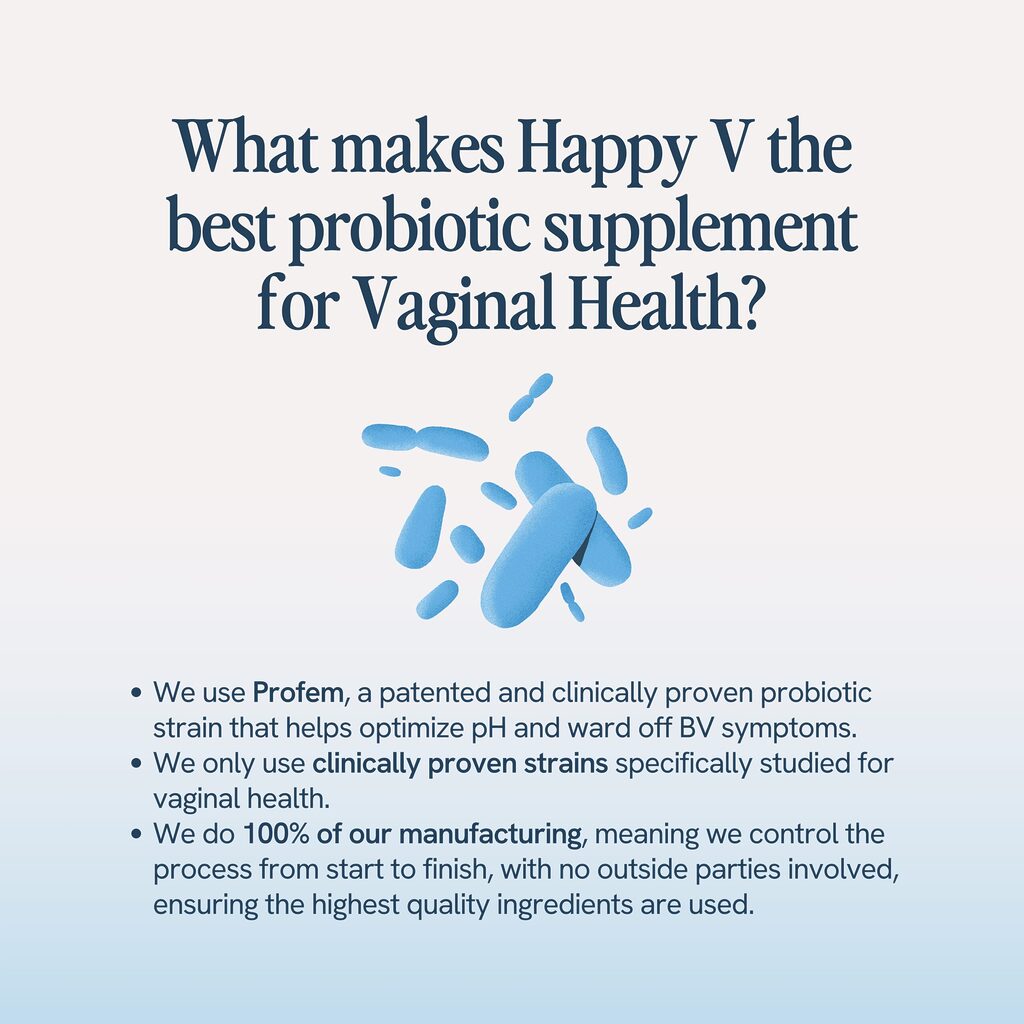
We’re so glad you asked! This is something we take a lot of pride in, and we have science (not just marketing jargon) to back up.
The first thing to know is that Happy V is not new to the probiotic game. For us, creating a daily probiotic was not about chasing a trend; it was about helping people experiencing the same vaginal health issues that we were. We were actually the first brand to use Profem, one of the few probiotic strains patented and clinically proven to optimize pH and ward off the symptoms of BV.
In fact, we only use clinically proven strains in our patented probiotic formula. And we make sure these strains have been explicitly studied regarding vaginal health, not digestive health or immunity. Take our strains LA-14 and HN001. These were clinically proven to optimize vaginal pH and ward off the symptoms of BV and yeast infections in a double-blind, placebo-controlled study.
At Happy V, we also do 100% of our manufacturing, meaning we control the process from start to finish, with no outside parties involved. This means we know with certainty that we are using the highest quality ingredients and can supply these high-quality ingredients at the lowest possible price. No, Happy V may not be the cheapest on the market, but we can guarantee it’s the most cost-effective, high-quality supplement you will find.
Plus, there are no fillers, binders, or carriers, and you can order it right online. We’ll ship them straight to your door every month, so you’ll never run out!
- A-
- A+
